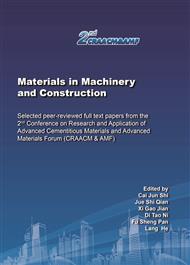[1]
L. Eusebio, A. Casali, M. Goisis, et al, Effects of superplasticizers structure on performance of Portland-based cements, Proc. Tenth ACI International Conference on Superplasticizers and Other Chemical Admixtures in Concrete, SP, 288(2012) 381-394.
DOI: 10.14359/51684242
Google Scholar
[2]
Z. Liran, W. Dongmin, L. Zhihua, Molecular design and performance research of early-type polycarboxylate superplasticizer, New Bui. Mater. 3(2012) 73-74.
Google Scholar
[3]
J. Plank, E. Sakai, C.W. Miao, et al, Chemical admixtures- Chemistry, applications and their impact on concrete microstructure and durability, Cem. Concr. Res., 78(2015) 81-99.
DOI: 10.1016/j.cemconres.2015.05.016
Google Scholar
[4]
Y. Peng, S. Jacobsen, Influence of water/cement ratio, admixtures and filler on sedimentation and bleeding of cement paste, Cem. Concr. Res. 54(2013), 133-142.
DOI: 10.1016/j.cemconres.2013.09.003
Google Scholar
[5]
P.H. Morris, P.F. Dux, Analytical solutions for bleeding of concrete due to consolidation, Cem. Concr. Res. 40(10) (2010) 1531-1540.
DOI: 10.1016/j.cemconres.2010.06.007
Google Scholar
[6]
T.S. Tan, T.H. Wee, S.A. Tan, et al, A consolidation model for bleeding of cement paste, Adv. Cem. Res. 1 (1)(1987) 18-26.
Google Scholar
[7]
N. Massoussi, E. Keita, N. Roussel, The heterogeneous nature of bleeding in cement pastes, Cem. Concr. Res. 95(2017) 108-116.
DOI: 10.1016/j.cemconres.2017.02.012
Google Scholar
[8]
Y. Yuan, R. Rezaee, M. Verrall, et al, Pore characterization and clay bound water assessment in shale with a combination of NMR and low-pressure nitrogen gas adsorption, Int. J. Coal. Geol. 194(2018) 11-21.
DOI: 10.1016/j.coal.2018.05.003
Google Scholar
[9]
Y.L. Ji, P. Leo, Z.P. Sun, The microstructure development during bleeding of cement paste: An NMR study, Cem.Concr. Res., 125(2019), 105866, ISSN 0008-8846.
DOI: 10.1016/j.cemconres.2019.105866
Google Scholar
[10]
Y.L. Ji, Z.P. Sun, X. Yang, et al, Assessment and mechanism study of bleeding process in cement paste by 1H low-field NMR, Constr. Build. Mater. 100(2015) 255-261.
DOI: 10.1016/j.conbuildmat.2015.09.062
Google Scholar
[11]
Y.L. Ji, Z.P. Sun, X.X. Jiang, et al, Fractal characterization on pore structure and analysis of fluidity and bleeding of fresh cement paste based on 1H low-field NMR, Constr. Build. Mater. 140(2017), 445-453.
DOI: 10.1016/j.conbuildmat.2017.02.151
Google Scholar
[12]
M.A. Javed, S. Komulainen, H. Daigle, B.Y. Zhang, J. Vaara, B. Zhou, V.V. Telkki, Determination of pore structures and dynamics of fluids in hydrated cements and natural shales by various 1H and 129Xe NMR methods, Micr. Meso. Mater. 218(2019) 66-74.
DOI: 10.1016/j.micromeso.2019.02.034
Google Scholar
[13]
Y.L. Ji, P. Leo, Z.P. Sun, et al, NMR study on the pore structure development of cement paste with bleeding during hydration, J. Mater. Civ. Eng., 2020, 32(12) 04020365.
DOI: 10.1061/(asce)mt.1943-5533.0003469
Google Scholar


